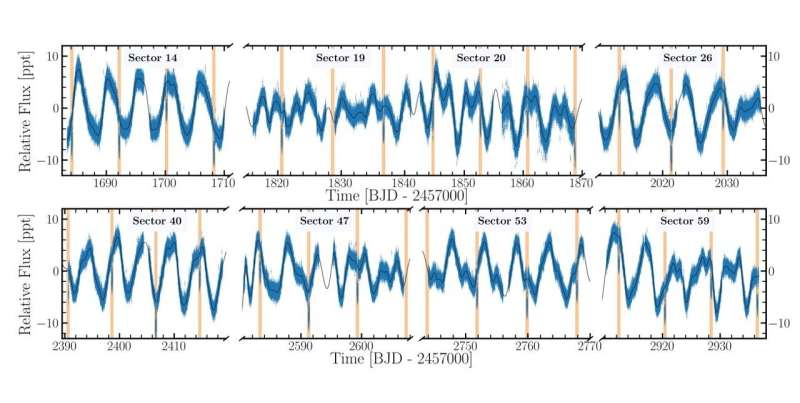March 5, 2024 report
This article has been reviewed according to Science X's editorial process and policies. Editors have highlighted the following attributes while ensuring the content's credibility:
fact-checked
preprint
trusted source
proofread
Astronomers discover new Saturn-sized exoplanet

An international team of astronomers reports the discovery of a new exoplanet orbiting a solar-type star. The newfound alien world, designated TOI-1135 b is young, hot and comparable in size to Saturn. The discovery was detailed in a paper published February 27 on the pre-print server arXiv.
To date, NASA's Transiting Exoplanet Survey Satellite (TESS) has identified nearly 7,100 candidate exoplanets (TESS Objects of Interest, or TOI), of which 420 have been confirmed so far. Since its launch in April 2018, TESS, with its array of wide-field cameras, is conducting a survey of about 200,000 of the brightest stars near the sun with the aim of searching for transiting exoplanets, including giant extrasolar worlds.
A group of astronomers led by Manuel Mallorquín Díaz of the University of La Laguna, Spain, has now confirmed another TOI monitored by TESS. They identified a transit signal in the light curve of TOI-1135 (also known as HIP 62908 or TIC 154872375)—a young solar-type star of spectral type G0 at a distance of some 371 light years. The planetary nature of this signal was confirmed by follow-up photometry and spectroscopy.
"This paper introduces the discovery and mass characterization of a close giant gas planet orbiting the young solar-type star TOI-1135," the researchers wrote.
TOI-1135 b has a radius of about 0.8 Jupiter radii and its mass is approximately 0.062 Jupiter masses, which yields a density at a level of 0.16 g/cm3. The planet orbits its host every 8.02 days, at a distance of 0.082 AU from it. The equilibrium temperature of TOI-1135 b is estimated to be around 950–1,200 K.
Therefore, the obtained results indicate that TOI-1135 b is an inflated exoplanet, similar in size to Saturn, however less massive than the solar system's two biggest gaseous giants. The planet has an extended atmosphere, most probably due to strong stellar radiation.
The astronomers assume that TOI-1135 b may be in the process of losing its atmosphere by photoevaporation. They noted that the planet has a high mass-loss rate of about 39 Earth masses per one billion years, so it will eventually lose most of its atmosphere in a few hundred million years.
"Giant planets with masses less than Saturn are susceptible to losing all or most of their atmosphere in their early stages if they receive enough radiation from a host star, which might be the case of TOI-1135 b," the authors of the paper explained.
The parent star, TOI-1135, is slightly larger and more massive than the sun, while its luminosity is at a level of 1.7 solar luminosities. The star is estimated to be between 125 million and 1 billion years old, and its effective temperature is approximately 6,122 K.
More information: Mallorquín et al, TOI-1135 b: A young hot Saturn-size planet orbiting a solar-type star, arXiv (2024). DOI: 10.48550/arxiv.2402.17448
Journal information: arXiv
© 2024 Science X Network





















